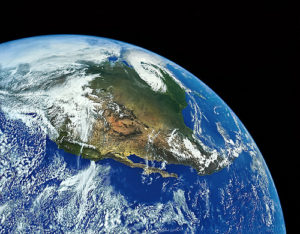 Significant contributions to this post were provided by former Computing Community Consortium (CCC) Council member and current Computing Research Association (CRA) Board member Shashi Shekhar from the University of Minnesota and Computing Research Association (CRA) Board member Kate Larson from the University of Waterloo as a representative of the Info-Can/CS-CAN.
Significant contributions to this post were provided by former Computing Community Consortium (CCC) Council member and current Computing Research Association (CRA) Board member Shashi Shekhar from the University of Minnesota and Computing Research Association (CRA) Board member Kate Larson from the University of Waterloo as a representative of the Info-Can/CS-CAN.
Fifty years ago on April 22, 1970, 20 million Americans, nearly 10% of the U.S. population at the time, took to the street, college campuses, and hundreds of cities to protest environmental ignorance and demand a new way forward for our planet. This first Earth Day launched a modern environmental movement to promote community action to address environmental challenges.
Past Earth Days have shaped public opinion and policy to address major problems such as ozone depletion, and DDT. However, the Earth is still facing new environmental challenges today. Recently, the United Nations has listed a set of sustainable development goals including climate action, life below water and on land, etc. Furthermore, the National Science Foundation (NSF) has started the “Navigating the New Arctic” initiative, as part of the NSF’s 10 big ideas to establish a sensor network and tools to record and understand the Arctic’s rapid biological, physical, and social changes.
Computing is crucial to addressing the challenges facing our changing planet. For example, sensor networks are needed to monitor our planet and help understand biological, physical, and social changes. Computational simulations are needed to help forecast rates of sea level change in polar ice shelves, predict critical atmosphere and geospace events. It is also important for many societal priorities including security, public health, smart cities, transportation, climate, environment, food, energy, water. Thus, Microsoft Research recently launched an initiative “AI for Earth” to address global environmental challenges. “Harnessing the Data Revolution,” a NSF’s 10 big idea, imagines real-time sensing/computation of observational data from the atmosphere, land and water to address societal challenges. In addition, multiple planetary-scale platforms for Earth data have emerged including the Earth on AWS, the Google Earth Engine and the NASA Earth Explorer. Furthermore, researchers are becoming aware of the environmental impacts of research activities, such as the greenhouse gases associated with the cloud computing as well as training of AI models, and a conference-driven publication culture.
Earth computing has unique characteristics. There are significant interactions among the vexing problems facing the Earth. For example, optimizing solutions for one problem may have unintended side-effects for other problems. Increased use of fertilizers for food production have adversely affected water quality. Furthermore, current computational models whether forward or inverse need to be viewed as approximations to Earth phenomena, whether physical, biological, behavioral or cultural. Progress is made by either improving the approximation or reducing computational cost or both. In addition, the training of machine learning and AI models faces great challenges due to non-stationarity of Earth phenomena (e.g., climate change) as well a lack of training samples as significant Earth events can be very rare and ground truth data are labor-intensive and time-consuming to collect. Moreover, addressing Earth problems often requires collaboration across many disciplines such as earth science, environmental science, geographic information science, social science, etc. This also corresponds to one of the NSF’s ten big ideas, namely, “Convergence Research,” which calls for solutions to real-world problems that require deep and sustained interdisciplinary collaboration.
Thus, it is timely for the computing community to join hands with other disciplines to better understand and protect our changing planet. Learn more about how you can participate in Earth Day 2020 here.
Resources for Further Exploration
[1] Earth Day at SIGKDD 2019, ACM SIGKDD International Conference on Knowledge Discovery and Data Mining, Anchorage, Alaska, August 5th, 2019.
[2] Andrew A. Chien, The Zero-Carbon Compute Project, University of Chicago Technical Report, October 1, 2019.
[3] J. Faghmous, V. Kumar and S. Shekhar, Computing and Climate, Guest Editor’s Introduction to the Special Issue of IEEE Computing in Science & Engineering, 17(6):6-8, Nov.-Dec. 2015 ( 10.1109/MCSE.2015.114 ).
[4] Y. Gil, S. Pierce, et. al., Intelligent systems for geosciences: an essential research agenda, Communications of the ACM, 62(1):76-84, 2018.
[5] Benjamin C. Pierce, Michael Hicks, Crista Lopes, and Jens Palsberg, Conferences in an Era of Expensive Carbon, Communications of the ACM, 63(3):35-37, March 2020.
[6] David Rolnick, Priya L. Donti, Lynn H. Kaack, Kelly Kochanski, Alexandre Lacoste, Kris Sankaran, Andrew Slavin Ross, Nikola Milojevic-Dupont, Natasha Jaques, Anna Waldman-Brown, Alexandra Luccioni, Tegan Maharaj, Evan D. Sherwin, S. Karthik Mukkavilli, Konrad P. Kording, Carla Gomes, Andrew Y. Ng, Demis Hassabis, John C. Platt, Felix Creutzig, Jennifer Chayes, and Yoshua Bengio, Tackling Climate Change with Machine Learning, ( https://arxiv.org/abs/1906.05433 ), June 2019.
[7] S. Shekhar and P. Vold, Spatial Computing, The MIT Press Essential Knowledge series, Feb. 2020 (isbn: 9780262538046).
[8] S. Shekhar, S. Feiner, and W. Aref, Spatial Computing, Communications of the ACM, 59(1):72-81, January, 2016.
[9] University Consortium for GIS, A UCGIS Call to Action: Bringing the Geospatial Perspective to Data Science Degrees and Curricula., Summer 2018. (https://www.ucgis.org/assets/docs/UCGIS-Statement-on-Data-Science-Summer2018.pdf)









